
Utricularia multifida, commonly called pink petticoat or fairy aprons, is a terrestrial carnivorous plant that belongs to the bladderwort genus, Utricularia, of family Lentibulariaceae. It is endemic to the south west corner of Western Australia. It was once placed in a separate genus as Polypompholyx multifida.
Utricularia westonii is a terrestrial carnivorous plant that belongs to the genus Utricularia. It is named for Dr. A. Weston who first discovered this species in 1971. It is endemic to Cape Le Grand National Park in Western Australia. It is the only member of section Tridentaria.
Utricularia antennifera is a terrestrial carnivorous plant that belongs to the genus Utricularia. It is endemic to Western Australia.
Utricularia dunstaniae is an annual terrestrial carnivorous plant that belongs to the genus Utricularia. Its distribution ranges from northern Western Australia to the Northern Territory.
Utricularia fistulosa is an affixed aquatic carnivorous plant that belongs to the genus Utricularia. It is a widespread species in the northeastern region of Western Australia.
Utricularia kimberleyensis, the Kimberley bladderwort, is a terrestrial carnivorous plant that belongs to the genus Utricularia. Its distribution ranges from the Dampier Peninsula in northern Western Australia to the area around Darwin in the Northern Territory.
Utricularia lasiocaulis is an annual terrestrial carnivorous plant that belongs to the genus Utricularia. Its distribution ranges from Western Australia through the Northern Territory and into Queensland, Australia.
Utricularia paulineae is an affixed aquatic carnivorous plant that belongs to the genus Utricularia. It is endemic to the coastal regions of Western Australia.
Utricularia quinquedentata is an annual, terrestrial carnivorous plant that belongs to the genus Utricularia. Its distribution ranges across northern Australia from Western Australia to northern Queensland and south to Brisbane. It was first identified by Ferdinand von Mueller as possibly a new species or variety in the early 1890s, noting it as "U. albiflora or a closely allied species." Mueller labeled one herbarium sheet as Utricularia albiflora var. quinquedentata. Without a valid description, according to the rules of botanical nomenclature, however, the epithet quinquedentata was not recognized until Peter Taylor validly published the species in 1986.
Utricularia pachyceras is a terrestrial carnivorous plant that belongs to the genus Utricularia. It is endemic to Western Australia and the Northern Territory.

Utricularia volubilis, the twining bladderwort, is a perennial, affixed aquatic carnivorous plant that belongs to the genus Utricularia. It is endemic to the southwestern coastal region of Western Australia.
Utricularia leptoplectra is a terrestrial or subaquatic carnivorous plant that belongs to the genus Utricularia. It is endemic to Australia with a distribution in the Northern Territory from the area around Darwin, east to the Arnhem Land plateau, south to Katherine, and west to the western Kimberley region in Western Australia.
Utricularia limosa is a terrestrial or subaquatic carnivorous plant that belongs to the genus Utricularia. It is endemic to Australia and Southeast Asia with distributions in China, Laos, Malaysia, New Guinea, the Northern Territory, Queensland, Thailand, Vietnam, and Western Australia.

Utricularia aurea, the golden bladderwort, is a medium- to large-sized suspended aquatic carnivorous plant that belongs to the genus Utricularia. It is the most common and widespread suspended aquatic species in Asia. Its native distribution ranges from India to Japan and Australia.

Utricularia chrysantha, the sun bladderwort, is a medium-sized annual, terrestrial carnivorous plant that belongs to the genus Utricularia. U. chrysantha is endemic to southern New Guinea and Australia. It grows as a terrestrial species in wet grasslands or Melaleuca-Acacia savannas at low altitudes near sea level. It was originally described and published by Robert Brown in 1810.

Utricularia simplex, commonly known as bluecoats, is a very small perennial carnivorous plant that belongs to the genus Utricularia. U. simplex is endemic to Western Australia. It grows as a terrestrial plant in peaty soils in heathland or swamps at altitudes near sea level. It was originally described and published by Robert Brown in 1810.

Utricularia uliginosa, the Asian bladderwort, is a small annual carnivorous plant that belongs to the genus Utricularia. It is native to Southeast Asia, Oceania, and Australia. U. uliginosa grows as a terrestrial or subaquatic plant in seasonally flooded shallow pools with sandy soils or on banks and among rocky stream beds at low altitudes. It was originally described by Martin Vahl in 1804.

Drosera menziesii, the pink rainbow, is an erect or scrambling perennial tuberous species in the carnivorous plant genus Drosera. It is endemic to Western Australia and grows in a variety of habitats, including winter-wet depressions, swamps, and granite outcrops in clay or peat sand soils or loam. D. menziesii produces small, circular carnivorous leaves along an undulating erect stem that can be .05–1.1 m (0.2–3.6 ft) high. Its pink flowers emerge from July to November.

Australia has one of the world's richest carnivorous plant floras, with around 187 recognised species from 6 genera.








